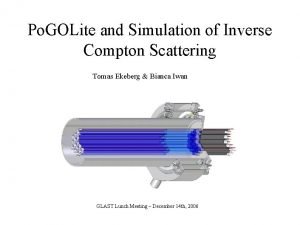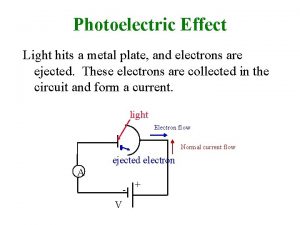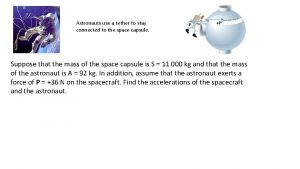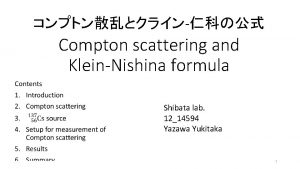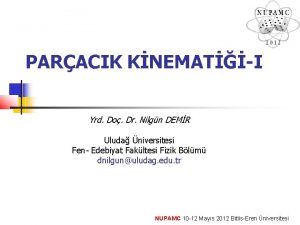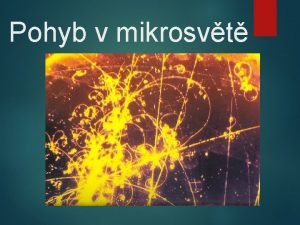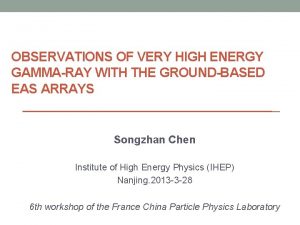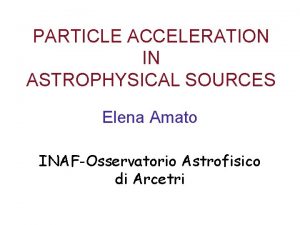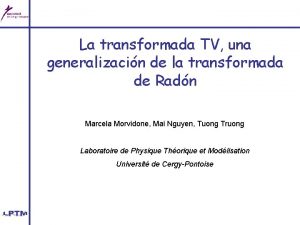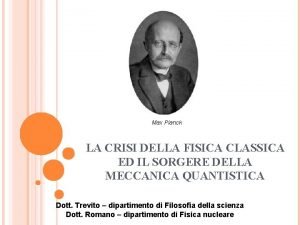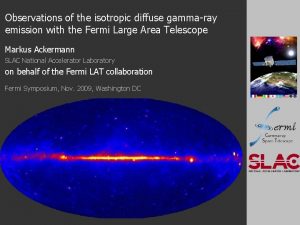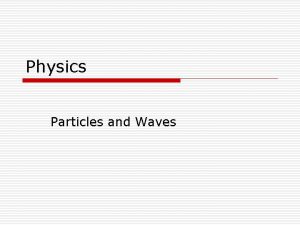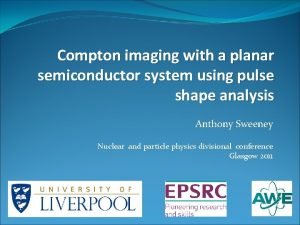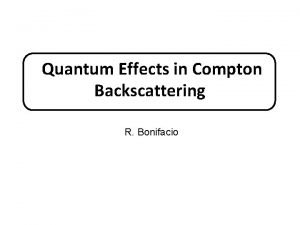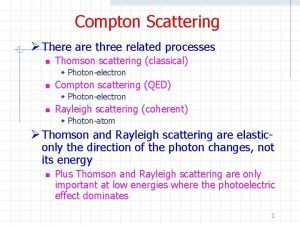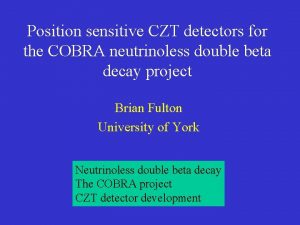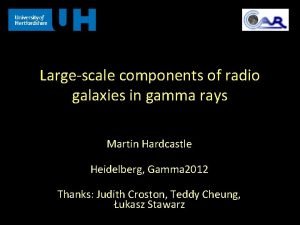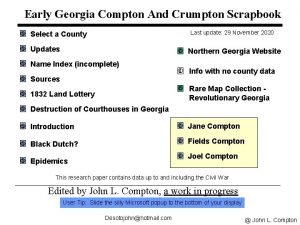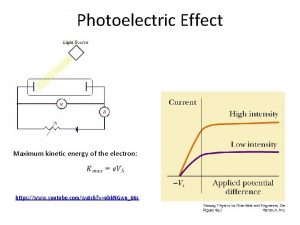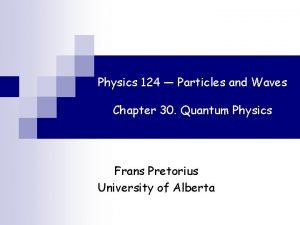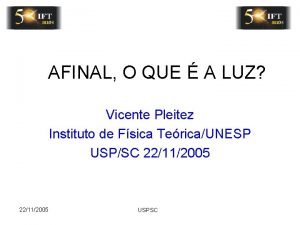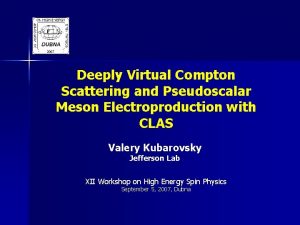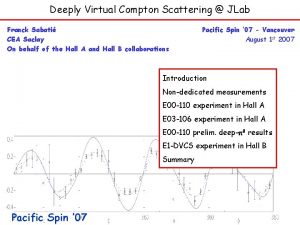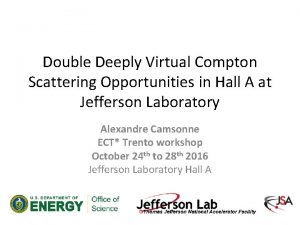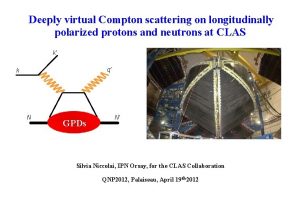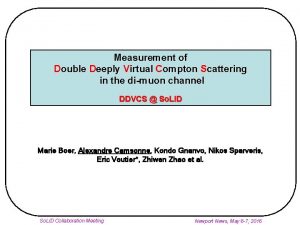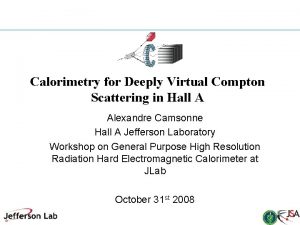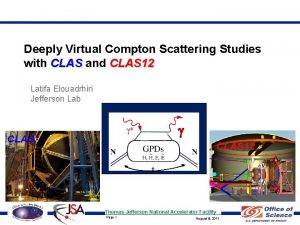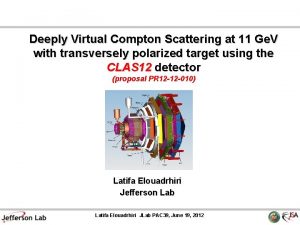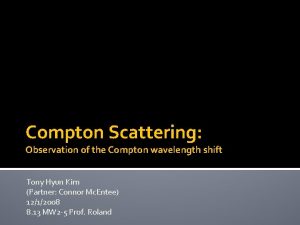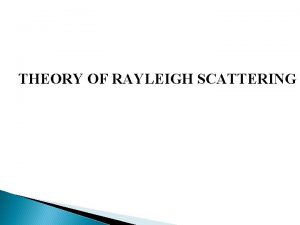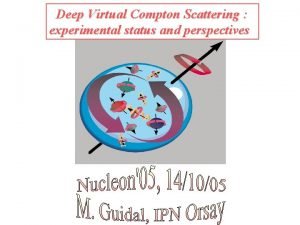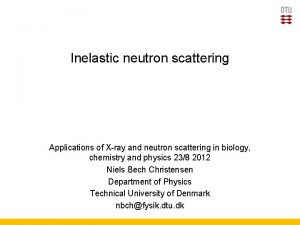Deeply Virtual Compton Scattering on the neutron nDVCS







































- Slides: 39

Deeply Virtual Compton Scattering on the neutron (n-DVCS) Meriem BENALI LPC de Clermont Ferrand, France Faculté des sciences de Monastir, Tunsia 1

Introduction v Elastic Scattering (W²=M²) Form Factors (Transverse position of partons) v Deeply (Q²>>M²) Inelastic (W²>>M²) Scattering (DIS) Parton Distribution Function ( PDFs) (Longitudinal momentum distribution of the partons in the nucleon) Two separate and non-correlated informations about the nucleon structure and they do not allow multi-dimensional description Some exclusive reactions of deep inelastic scattering (like the DVCS) can measure new quantities: (Generalized Parton Distribution GPDs) 2

Introduction v Deeply (Q²>>M²) Inelastic (W²>>M²) Scattering (DIS) v Elastic Scattering (W²=M²) Form Factors (Transverse position of partons) Parton Distribution Function ( PDFs) (Longitudinal momentum distribution of the partons in the nucleon) GPDs relate : Spatial parton distribution in the transverse plane (2 d) + Their longitudinal momentum fraction (1 d) Three-dimensional picture of the nucleon 3

Generalized Parton Distribution GPDs At leading order, 4 GPDs : , v Link to Parton distribution functions (ξ=t=0) = q(x) ; Ø Link to Form Factors ( Ɐ ξ) x>0 = - q(x) x<0 = ∆q(x) ; x>0 = ∆ q(-x) ; x<0 Ø Access to quark angular momentum, via Ji sum rule [X. Ji 1997]: ØSolve the problem of the "spin crisis" ? ? spin quarks contribution Spin gluons Quarks and gluons orbital contribution momentum contributions 4

How to measure GPDs ? Deeply Virtual Compton Scattering (DVCS ) The simplest exclusive process that can be described in terms of GPDs by measuring its cross section At Bjorken regime ( ) Bjorken Variable Perturbative part (calculable) ü : longitudinal momentum fraction ü : GPDs skewness invariant Non perturbative part parameterized by ü t : squared momentum transfer GPDs 5 The dominant process (The Handbag diagram) 5

Total cross section Known term Real part Imaginary part The unpolarized cross section accesses the real part of DVCS and the |TDVCS|2 term which are sensitive to an integral of GPDs over x The polarized cross-section difference accesses the imaginary part of DVCS and therefore GPDs at x=±ξ 6

Total cross section GPDs The unpolarized cross section (using the Belitsky and Mueller formalism) Interference A. V. Belitsky, D. Mueller Phys. Rev. , D 82: 074010, 2010 The observable is a linear combination of form factors and Compton form factors : Compton form factors(CFFs) Since F 2> F 1 for the neutron: GPD 7

Motivation (DVCS on the neutron) v Measure cross section at different kinematics (2 beam energies) Ø Separates the. I(TBHTDVCS) of DVCS and the |TDVCS|2 Ø Better constrain theoretical models of GPDs Measure n-DVCS cross section is important • Neutron has different flavors from the proton • Sensitive to GPD E ( The less constrained GPD and which is important to access quarks orbital momentum via Ji’s sum rule) The E 08 -025 (n-DVCS) experiment (DVCS on the neutron) Q² (Ge. V²) 1. 75 x. B 0. 36 Ebeam(Ge. V) 4. 45 (Kin 2 Low) and 5. 54 (kin 2 high) Target LH 2 and LD 2 8

CEBAF The E 08 -025 (n-DVCS) experiment was performed at JLab Hall A in 2010. Ø Goal : Measure the n-DVCS total cross-sections 6 Ge. V v Hall A at Jefferson Lab (Newport, Virginia, USA) • Ebeam = 4. 45 Ge. V and Ebeam=5. 54 Ge. V • beam intensity I= 3 µA • Polarisation du faisceau 72% et 76% • Résolution en énergie du faisceau ~10 -4 (expériences de haute précision) 9

Experimental apparatus High Resolution Spectrometers • Maximal momentum 4 Ge. V/c • Momentum acceptance ± 5% • Momentum Resolution ~10 -4 • Solid angle ∆Ω 7 msr Recoil nucleon not detected v. The data were taken at two kinematics: ü Beam energy = 4. 45 Ge. V & 5. 54 Ge. V üQ² = 1. 75 Ge. V² ü x. Bj = 0. 36 ü t ~ [-0. 5 , -0. 1] Ge. V 2 ü Maximal luminosity = 3. 1037 cm-2 s-1 8 Electromagnetic Calorimeter • 13 x 16 Pb. F 2 blocks (Čerenkov light detection) • Block size: 3 x 3 cm² x 20 X 0 • Each block is connected to (PMT + base + ARS) • The energy deposit determination is based on a wave form analysis of the ARS signals. Blocks blacken under the radiation effect: the gains of the blocks decreases Calibrate the response of the EM calorimeter

Calorimeter energy calibration Method: the calibration method is based on the comparison between the measured energy of a detected π0 from H(e, e’ π0)p events and its expected energy calculated with its scattering angle. e N e’ π0 N γ γ After the minimization we get the calibration coefficients for each block i Sum over all events Calculated energy measured energy in of pion one block Sum over all Calibration blocks coefficients Ø To select the H(e, e’ π0)p events Mπ0 (Missing mass)² =( k + p - k’ - q 1 - q 2 )² Mp² (invariant mass of two detected photons )²=(q 1+q 2)² 9 11

Calorimeter energy calibration Calibration result Invariant mass peak position § Minv before calibration * Minv after calibrationc Kin 2_low Kin 2_high (Missing mass)² peak position § M²X before calibration * M²X after calibration Kin 2_low Kin 2_high M(π0)≈ 0. 135 Ge. V M²p≈ 0. 88 Ge. V² After the π0 calibration we reproduce: the π0 mass & the proton mass Each group number correspond to 1 or 2 days of data taking This method allows a daily calibration of the calorimeter energy 12

Selection of the n-DVCS events v In order to select the DVCS events: (Missing mass)²= (e + N - e’ - γ)² Subtraction of the accidentals (When the detected photon is fortuitous coincidence with the scattered electron D(e, e’ γ)X H(e, e’ γ)X Subtraction of the π0 contamination (When the detected photon come from the decay of π0 and resemble kinematically to a photon DVCS) threshold pion production Subtracting the π0 contamination from e. N→e π0 X events detected • cut at MX 2 < (MN +Mπ0)2 =1. 15 Ge. V² ØTo ensure the reaction exclusivity Ø To subtract the channels associated with the DVCS: e. N e’N’π0 γ (MX 2 =1. 15 Ge. V²) e. N e’∆γ (MX 2 =1. 50 Ge. V²) 11

Selection of the n-DVCS events After • subtracting the accidentals, • subtracting single photons coming from π0 decay (π0 contamination), • adding Fermi momentum to H 2 data, __. __ D(e, e’γ)X - acc - π0 cont • normalizing H 2 and D 2 data to the same luminosity, __. __ H(e, e’γ)X – acc - π0 cont Ø we obtain the difference (D(e, e' γ)X- H(e, e' γ)X ) __. __ D(e, e’γ)X-H(e, e’γ)X Ebeam=4. 45 Ge. V D(e, e’ γ)X-H(e, e’ γ)X MX 2 = 0. 95 Ge. V² 1. 15 Ge. V² Ebeam=5. 54 Ge. V D(e, e’ γ)X-H(e, e’ γ)X 1. 15 Ge. V² MX 2 = 0. 95 Ge. V² MX 2 (Ge. V 2) MX 12 2 (Ge. V 2) 14

Adjusting the simulation to the experimental data Experimental data obtained + Simulated data: 1 - have the same cuts applied to the experimental data 2 - have the same resolution and the same calibration that experimental data Simulation before smearing Adjustment : Simulation after smearing Cross Section Experimental data Result of smearing for one bin in (t, φ) 15

Extraction of the cross section Binning : 4 bins on t (squared momentum transfer)× 20 bins on φ Events number in the simulation in one bin at the vertex luminosity solid angle differential cross section kinematic variables The unpolarized (n. DVCS + coherent d. DVCS) total cross section (simplified expression) : BH _neutron contribution BH_coherent deuteron contribution kinematical (DVCS²+I) neutron factor Contribution Calculated with elastic form factors Dependence in φ Separate the different neutron contributions Xin (neutron) (or Xid (coherent deuton)) Binning in Mx 2 Separate contributions Xin des Xid: Mx²d ≈ Mx²n+t/2 (DVCS²+I) Coherent deuteron Contribution ___ n-DVCS simulation ___d-DVCS simulation The observables we want to extract: these are linear t/2 combinations of CFFS which contains GPDs (unknown) ≈Mn² + t/2 ≈Mn²_neutron A. V. Belitsky, D. Mueller Phys. Rev. , D 82: 074010, 16 2010

Extraction of the cross section Binning : 4 bins on t (squared momentum transfer)× 20 bins on φ A χ² minimization between the smeared simulation and experimental data: Number of experimental events in one bin k The statistical errors in one bin k Events Number in the simulation in one experimental bin e Events Number in the simulation in one Vertex bin v migration probability of an event at the vertex “v” to an experimental bin “e” The cross section : Values of the 17

(n-DVCS +d-DVCS) cross section Experimental cross section and (BHneutron+BHdeuton) (D(e, e’γ)X - H(e, e’ γ)X) = (n-DVCS+d-DVCS+BHneutron+BHdeuton) < t >=-0. 25 Ge. V² , MX²<0. 95 Ge. V² Ebeam=5. 54 Ge. V Ebeam=4. 45 Ge. V Y R A N I M I PREL Ø Experimental cross section > (n-BH + d-BH) Ø These results show for the first time the existence of a positive contribution of n-DVCS (+ d-DVCS) at both beam energies 18

(n-DVCS +d-DVCS) cross section σ(exp) σ(fitted) total neutron contribution total coherent-deuton contribution <t_n>=-0. 41 Ge. V², <t_d>=-0. 33 Ge. V² <t_n>=-0. 31 Ge. V², <t_d>=-0. 26 Ge. V² Y R A N I M I PREL <t_n>=-0. 25 Ge. V², <t_d>=-0. 20 Ge. V² <t_n>=-0. 18 Ge. V², <t_d>=-0. 14 Ge. V² Ø Total cross section is small at large | t | ØThe coherent-deuteron contribution is dominant at small | t | 19

(n-DVCS +d-DVCS) cross section Stability and systematic errors Ø results are stable as a function of MX² cut and binning on MX 2 : Y R A MIN I L E PR 1. 00 Ge. V 2 0. 95 Ge. V 2 0. 90 Ge. V 2 Ø Systematic errors : * Systematic errors on the normalization (2. 7%) + * Systematic errors related to the cut on MX 2 Y R A MIN I L E PR 20

Conclusion ü Extraction of the preliminary experimental cross section (neutron + deuton Coherent) for two energy beam üThese results show for the first time the existence of a positive contribution of n-DVCS (+ d-DVCS) {Expérimental cross section > (n-BH+d-BH)}: üFor two beam energy (Low and High) üFor 4 bins in t üFor different MX² cuts ü For different binning in Mx² üPreliminary estimate for systematic errors • Stability and correlation studies to estimate separately the contributions of n-DVCS and d -DVCS still to be done. • Using these experimental results and theoretical models to constrain GPDs 21

22

23

CEBAF 126 Ge. V Upgrade CHL -2 üIncreasing beam energy ünew experience on the DVCS v Hall A at Jefferson Lab proton(Q²>2 Ge. V², x. B est variable) (Newport, Virginia, USA) running • Ebeam = 4. 45 Ge. V and Ebeam=5. 54 Ge. V ü Unfortunately No n-DVCS • I= 3 µA experience in Hall A, • Polarisation du faisceau 72% et 76% ü DVCS on the neutron in Hall B (using central detector of the neutron • Résolution d’énergie du faisceau in CLAS 12) ~10 -4 (High precision experiments) 24

Calorimeter energy calibration Calibration method e. N e’ π0 N γ 1 γ 2 (Detected) The calibration method is based on the comparison between the measured energy of a detected π0 from H(e, e’ π0)p events and its expected energy calculated with its scattering angle: ? ? Sum over all events After the minimization we get the coefficients for each block i Sum over all blocks Calculated energy of pion measured energy in one block (elastically calibrated) Calibration coefficients The momentum of π0 reconstructed using Many iterations to get the final coefficients for each block i 25

Calorimeter energy calibration Select the H(e, e’ π0)p events (invariant mass of the tow detected photons )² Minv²=(q 1+q 2)² (missing masse squared) MX²=( k + p - k’ - q 1 - q 2 )² Mp² Mπ0 ü Correlation between Minv et MX 2 üTwo dimensional cut for select H(e, e’ π0)p events 26

Selection of the n-DVCS events 1 - Accidental subtraction The raw data: e 'and γ are coincident ( e. N e’ γ X) • 1 track in the HRS and 1 cluster in the calorimeter (energy> 1 Ge. V) The detected photon may be in fortuitous coincidence with the scattered electron ) Arrival time spectrum of photons in the calorimeter (ns) true coincidences 1 - selection of accidentals Ø [-3, 3]ns: coincidence events(DVCS+ accidentals) Ø[-11, -5]ns and [5, 11]ns : accidentals 2 - Accidental subtraction Spectrum : MX²= (e + N - e’ - γ)² raw D(e, e’γ)X raw H(e, e’γ)X Accidentals D(e, e’γ)X-accidentals Accidentals H(e, e’γ)X-accidentals 41. 5% 24. 5% 27

Selection of the n-DVCS events 2 - π0 contamination subtraction The photon detected in the calorimeter may come from the decay of π0 and resembles kinematically to a DVCS photon : e. N e’π0 X e’ γ 1 γ 2 X π0 decay in γ 1 γ 2 CM frame Laboratory frame Two clusters events: e. N e’π0 X e’ γ 1 γ 2 X γ 2 Symmetric decay Simulation Direction of Lorentz Boost γ 2 γ 1 Asymmetric decay γ 1 NT = N 0γ + N 1γ + N 2 γ 0 detected photon 1 detected photon 2 detected photons 1 detected photon = π0 contamination 28

Selection of the n-DVCS events 2 - π0 contamination subtraction D(e, e’γ)X-accidentals H(e, e’γ)X-accidentals D(e, e’γ)X-accidentals- π0 contamination 19% H(e, e’γ)X-accidentals-cont π0 π0 contamination 13. 27% MX 2 = 0. 95 Ge. V² Pion production threshold cut at MX 2 < (MN +Mπ0)2=1. 15 Ge. V² ØTo ensure the reaction exclusivity Ø To subtract the channels associated with the DVCS: e. N e’N’π0 γ (MX 2 =1. 15 Ge. V²) e. N e’∆γ (MX 2 =1. 50 Ge. V²) … 29

Smearing of the simulation data Method: To reproduce the resolution of experimental data, we chose to smear the photon energy for each event in the simulation by bin on t and φ. for 1 bin in (t, φ) fit of the simulation data by a Gaussian fit of the experimental data by a Gaussian E(Exp-th) (E(MC-th) ) The photon energy in the simulation is smeared by: 30

Smearing of the simulation data Smearing Result for 1 bin in (t, φ ) Simulation before simulation Simulation after simulation Experimental data 31

Smearing of the simulation data Smearing Result For 5 in t and 20 in φ Ø Good agreement between the resolution of the data and the simulation for each bin (t and φ) ØGood agreement between the calibration of the data and the simulation for each bin (t and φ) ØThe first 20 bins are rejected (blocks on board of the calorimeter) Ø The coefficients of the smearing determined with LH 2_data and the p_DVCS simulation are then applied to d_DVCS and n_DVCS simulation. Résolution (largeur du pic) 32

Smearing of the simulation data Smearing Result For 5 in t and 20 in φ Ø Good agreement between the resolution of the data and the simulation for each bin (t and φ) ØGood agreement between the calibration of the data and the simulation for each bin (t and φ) ØThe first 20 bins are rejected (blocks on board of the calorimeter) Ø The coefficients of the smearing determined with LH 2_data and the p_DVCS simulation are then applied to d_DVCS and n_DVCS simulation. Calibration (position du pic) 33

Smearing of the simulation data Smearing Result For 5 in t and 20 in φ Ø Good agreement between the resolution of the data and the simulation for each bin (t and φ) ØGood agreement between the calibration of the data and the simulation for each bin (t and φ) ØThe first 20 bins are rejected (blocks on board of the calorimeter) Ø The coefficients of the smearing determined with LH 2_data and the p_DVCS simulation are then applied to d_DVCS and n_DVCS simulation. Calibration (position du pic) The first 20 bins are rejected 34

Smearing of the simulation data Smearing Result For 5 in t and 20 in φ Ø Good agreement between the resolution of the data and the simulation for each bin (t and φ) ØGood agreement between the calibration of the data and the simulation for each bin (t and φ) ØThe first 20 bins are rejected (blocks on board of the calorimeter) Ø The coefficients of the smearing determined with LH 2_data and the p_DVCS simulation are then applied to d_DVCS and n_DVCS simulation. Calibration (position du pic) The first 20 bins are rejected 35

Extraction of the cross section Binning : 4 bins on t (squared momentum transfer)× 20 bins on φ Events number in the simulation in one bin at the vertex luminosity solid angle differential cross section kinematic variables The unpolarized (n. DVCS + d. DVCS) total cross section (simplified expression) : BH _neutron contribution Facteurs (DVCS²+I) neutron BH_coherent deuteron cinématiques Contribution contribution Calculated with elastic form factors Dependence in φ Separate the different neutron contributions Xin (neutron) (or Xid (coherent deuton)) Binning in Mx 2 Separate contributions Xin des Xid: Mx²d ≈ Mx²n+t/2 (DVCS²+I) Coherent deuteron Contribution ___ n-DVCS simulation ___d-DVCS simulation The observables we want to extract: these are linear t/2 combinations of CFFS which contains GPDs (unknown) ≈Mn² + t/2 ≈Mn²_neutron 36

Extraction of the cross section ØAccording to the formalism of Muller Belitsky and the differential cross section is: Terme connu 1 2 9 Contributions !! ( we can’t fit everything) 3 37 A. V. Belitsky, D. Mueller Phys. Rev. , D 82: 074010, 2010

A. V. Belitsky, D. Muller Phys. Rev. , D 82: 074010, 2010 In the new BKM Formalism we have: We chose to fit only 6 CFFs: 9 CFFs for the neutron 9 CFFs for the coherent deuton 18 Contributions !! ( we can’t fit everything) 3 Xin = Re(CI)n , Re(CIFeff)n , Cn. DVCS AND 3 Xid = Re(CI)d , Re(CIFeff)d , Cd. DVCS BUT: These coefficients Xin and Xid are effective coefficients AND These coefficients are not stable (event if the χ² of the fit is good) as a function of: v. Cut on Mx² vthe binning on Mx² v. The number of contributions to fit Only the BH_contributions and the total experimental cross section will be shown 38

ØObservables: 3 Xin = Re(CI)n , Re(CIFeff)n , Cn. DVCS/// Re(CI)d , Re(CIFeff)d , Cd. DVCS ----- Kin 2 low Valeur de l’observable Re(CI)neutron Re(CI ---- Kin 2 hign, CDVCSneutron Feff)neutron <t> Ge. V² Re(CI)deuton CDVCSdeuton Re(CIFeff)deuton <t> Ge. V² 39 <t> Ge. V²
 Golite trig 2
Golite trig 2 Photoelectric effect สรุป
Photoelectric effect สรุป Photoelectric and compton effect
Photoelectric and compton effect Compton scattering
Compton scattering Compton effect
Compton effect To become deeply aware through the senses
To become deeply aware through the senses Foresight is deeply rooted within intuitive mind
Foresight is deeply rooted within intuitive mind Suppose your car was mired deeply in the mud
Suppose your car was mired deeply in the mud Watson health francisco 1b
Watson health francisco 1b Compton effect formula
Compton effect formula Victorian curriculum economics and business
Victorian curriculum economics and business Stephenie compton email
Stephenie compton email North compton wildcats
North compton wildcats Compton saçılması
Compton saçılması Crisi fisica classica
Crisi fisica classica Arthur compton experiment
Arthur compton experiment Efecto compton
Efecto compton Inverse compton
Inverse compton Pion decay
Pion decay Compton saçılması
Compton saçılması Efecto compton
Efecto compton Hiệu ứng compton
Hiệu ứng compton Compton olayi
Compton olayi Effetto compton
Effetto compton Isodosis
Isodosis Inverse compton
Inverse compton Effetto compton
Effetto compton Wavesap
Wavesap Compton
Compton Compton scatter radiology
Compton scatter radiology Compton backscattering
Compton backscattering Photoelectric and compton effect
Photoelectric and compton effect Compton
Compton Bad sight
Bad sight Ngc 6251
Ngc 6251 Georgia compton
Georgia compton Photoelectric
Photoelectric Compton wavelength
Compton wavelength Efeito fotoelétrico einstein
Efeito fotoelétrico einstein Has virtual functions and accessible non-virtual destructor
Has virtual functions and accessible non-virtual destructor
